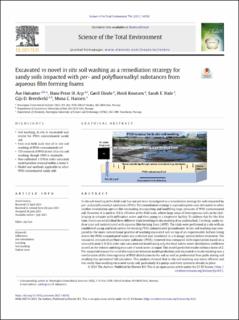| dc.contributor.author | Høisæter, Åse | |
| dc.contributor.author | Arp, Hans Peter | |
| dc.contributor.author | Slinde, Gøril | |
| dc.contributor.author | Knutsen, Heidi | |
| dc.contributor.author | Hale, Sarah | |
| dc.contributor.author | Breedveld, Gijs D. | |
| dc.contributor.author | Hansen, Mona Cecilie | |
| dc.date.accessioned | 2022-02-15T11:12:31Z | |
| dc.date.available | 2022-02-15T11:12:31Z | |
| dc.date.created | 2021-07-21T12:28:51Z | |
| dc.date.issued | 2021 | |
| dc.identifier.citation | Science of the Total Environment. 2021, 794 1-9. | en_US |
| dc.identifier.issn | 0048-9697 | |
| dc.identifier.uri | https://hdl.handle.net/11250/2979061 | |
| dc.description.abstract | In situ soil washing at the field scale has not yet been investigated as a remediation strategy for soils impacted by per- and polyfluoroalkyl substances (PFAS). This remediation strategy is a promising low-cost alternative to other costlier remediation options like excavating, transporting and landfilling large amounts of PFAS contaminated soil. However, it is unclear if it is effective at the field scale, where large areas of heterogenous soil can be challenging to saturate with infiltration water and then pump to a treatment facility. To address this for the first time, herein we established three different trials involving in situ washing of an undisturbed, 3 m deep, sandy vadose zone soil contaminated with aqueous film forming foam (AFFF). The trials were performed at a site with an established pump and treat system for treating PFAS contaminated groundwater. In situ soil washing was compared to the more conventional practice of washing excavated soil on top of an impermeable bottom lining where the PFAS contaminated water was collected and monitored in a drainage system before treatment. The measured amount of perfluorooctane sulfonate (PFOS) removed was compared with expectations based on a non-calibrated, 1-D first order rate saturated soil model using only the local soil-to-water distribution coefficient as well as the volume and irrigation rate of wash water as input. This model predicted results within a factor of 2. The suspected reasons for small discrepancies between model predictions and excavated vs in situ washing was a combination of the heterogeneity of PFOS distribution in the soil as well as preferential flow paths during soil washing that prevented full saturation. This analysis showed that in situ soil washing was more efficient and less costly than washing excavated sandy soil, particularly if a pump-and-treat system is already in place. | en_US |
| dc.language.iso | eng | en_US |
| dc.publisher | Elsevier | en_US |
| dc.rights | Navngivelse 4.0 Internasjonal | * |
| dc.rights.uri | http://creativecommons.org/licenses/by/4.0/deed.no | * |
| dc.title | Excavated vs novel in situ soil washing as a remediation strategy for sandy soils impacted with per- and polyfluoroalkyl substances from aqueous film forming foams | en_US |
| dc.type | Peer reviewed | en_US |
| dc.type | Journal article | en_US |
| dc.description.version | publishedVersion | en_US |
| dc.source.pagenumber | 1-9 | en_US |
| dc.source.volume | 794 | en_US |
| dc.source.journal | Science of the Total Environment | en_US |
| dc.identifier.doi | 10.1016/j.scitotenv.2021.148763 | |
| dc.identifier.cristin | 1922328 | |
| dc.relation.project | Norges forskningsråd: 302371 | en_US |
| cristin.ispublished | true | |
| cristin.fulltext | original | |
| cristin.qualitycode | 2 | |

